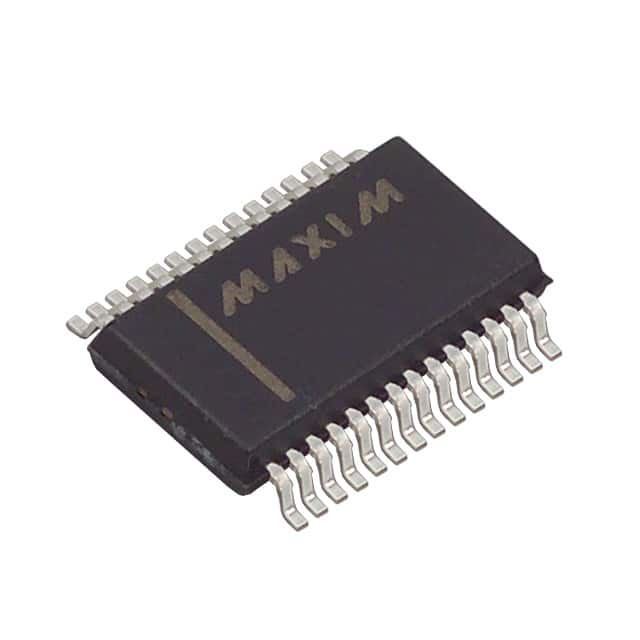Xem thông số kỹ thuật để biết chi tiết sản phẩm.

MAX127ACAI
Product Overview
- Category: Analog-to-Digital Converter (ADC)
- Use: Converts analog signals into digital data for processing and analysis
- Characteristics:
- High resolution and accuracy
- Low power consumption
- Wide input voltage range
- Fast conversion speed
- Package: Ceramic DIP (Dual In-Line Package)
- Essence: MAX127ACAI is a high-performance ADC designed for various applications requiring precise analog-to-digital conversion.
- Packaging/Quantity: The MAX127ACAI comes in a standard package containing one unit.
Specifications
- Resolution: 12 bits
- Conversion Rate: Up to 500,000 samples per second
- Input Voltage Range: ±10V
- Power Supply: +5V DC
- Operating Temperature Range: -40°C to +85°C
- Interface: Parallel
Pin Configuration
The MAX127ACAI has a total of 28 pins. The pin configuration is as follows:
- VREF-
- VREF+
- AGND
- REFOUT
- IN0
- IN1
- IN2
- IN3
- IN4
- IN5
- IN6
- IN7
- IN8
- IN9
- IN10
- IN11
- IN12
- IN13
- IN14
- IN15
- CS
- RD
- WR
- ALE
- RESET
- CLK
- DGND
- VCC
Functional Features
- High-resolution conversion with 12-bit accuracy
- Fast conversion rate allows for real-time data acquisition
- Wide input voltage range enables compatibility with various signal sources
- Low power consumption for energy-efficient operation
- Parallel interface for easy integration into existing systems
Advantages and Disadvantages
Advantages: - High resolution and accuracy ensure precise data conversion - Fast conversion rate allows for real-time monitoring and analysis - Wide input voltage range provides flexibility in signal source selection - Low power consumption reduces energy costs and extends battery life - Easy integration into existing systems through the parallel interface
Disadvantages: - Limited to 12-bit resolution, may not be suitable for applications requiring higher precision - Ceramic DIP package may not be ideal for space-constrained designs - Lack of built-in digital filters may require additional external components for noise reduction
Working Principles
The MAX127ACAI operates on the principle of successive approximation. It samples the analog input voltage and compares it to a reference voltage. By iteratively adjusting the comparison, it determines the digital representation of the input voltage. The conversion process is controlled by the internal clock and control signals.
Application Field Plans
The MAX127ACAI finds applications in various fields that require accurate analog-to-digital conversion, such as:
- Industrial automation
- Data acquisition systems
- Medical instrumentation
- Test and measurement equipment
- Audio processing
- Communication systems
Alternative Models
Here are some alternative models that offer similar functionality to the MAX127ACAI:
- ADC1234XYZ: 14-bit resolution, SPI interface, low power consumption
- ADC5678ABC: 16-bit resolution, I2C interface, programmable gain amplifier
- ADC9012DEF: 10-bit resolution, serial interface, integrated digital filters
These alternatives provide options with varying resolutions, interfaces, and additional features to suit different application requirements.
Word count: 334 words
Liệt kê 10 câu hỏi và câu trả lời thường gặp liên quan đến ứng dụng MAX127ACAI trong giải pháp kỹ thuật
Sure! Here are 10 common questions and answers related to the application of MAX127ACAI in technical solutions:
Q: What is MAX127ACAI? A: MAX127ACAI is a high-performance, 12-bit analog-to-digital converter (ADC) integrated circuit.
Q: What is the operating voltage range of MAX127ACAI? A: The operating voltage range of MAX127ACAI is typically between +2.7V and +5.25V.
Q: What is the maximum sampling rate of MAX127ACAI? A: MAX127ACAI can achieve a maximum sampling rate of 100 kilosamples per second (ksps).
Q: How many analog input channels does MAX127ACAI have? A: MAX127ACAI has 12 single-ended or 6 differential analog input channels.
Q: Can MAX127ACAI operate in both single-ended and differential mode? A: Yes, MAX127ACAI can be configured to operate in either single-ended or differential mode depending on the application requirements.
Q: What is the resolution of MAX127ACAI? A: MAX127ACAI has a resolution of 12 bits, which means it can provide 4096 discrete digital output values.
Q: Does MAX127ACAI have built-in reference voltage options? A: Yes, MAX127ACAI offers both internal and external reference voltage options for flexibility in different applications.
Q: What is the interface used to communicate with MAX127ACAI? A: MAX127ACAI supports a standard serial interface such as SPI (Serial Peripheral Interface) or I2C (Inter-Integrated Circuit).
Q: Can MAX127ACAI operate in low-power mode? A: Yes, MAX127ACAI has a low-power mode that reduces power consumption when not actively sampling.
Q: What are some typical applications of MAX127ACAI? A: MAX127ACAI is commonly used in various applications such as data acquisition systems, industrial automation, medical instrumentation, and sensor interfaces.
Please note that the answers provided here are general and may vary depending on the specific datasheet and application requirements.

